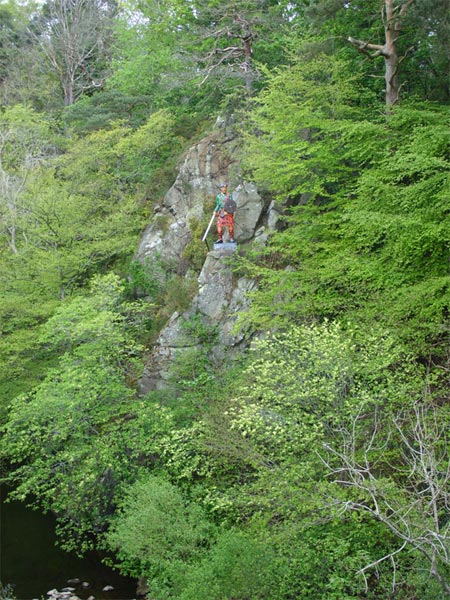Location
Just before the A93 leaves Peterculter at its western end, the road passes across a bridge over the Culter Burn. The statue is seen from the bridge, looking north.
Peterculter, Aberdeen, Aberdeenshire
OS Map Reference
NJ 835 009
Date
1991
Description
A polychrome carved wood statue in a folk style depicting the popular archetype of the 18th century highland warrior. In tartan plaid armed with broadsword, pistol and targe. Romantically situated on a rock in the side of the burn's gorge.
Related Information
There have been four different "Rob Roy" statues in this location since around 1850, a ships figurehead of the Highlander was brought out from the docks of Aberdeen with the esparto grass and rags for use in the nearby paper mill. John Anderson, a carter employed by the mill had a brother on board the eponymous whaling ship "Rob Roy" and from him he had got the redundant figurehead. Two logs of wood were stuck on for legs, a pair of lead boots were made and a piece of canvas served as a kilt. The manager of the mill, Robert Arbuthnott, gave permission to place the commanding figure up on the craggy rocks of the Culter Burn.
This wooden figure lasted until about 1865 when a replacement was commissioned by public subscription. Mr Stephen, farmer at Alton Farm was created Provost of Culter for the day for its unveiling. The statue was well maintained but suffered the indignity of being used as target practice by the Territorials before the First World War.
In 1926 ,a third incarnation of Rob Roy was created carved from a log of Yellow Pine by a woodcarver, called Graham of the Hardgate, in Aberdeen. For many years a local painter, George Shaw, undertook the hazardous task of varnishing and repainting the Highlander. 20 shades of paint were needed for his make-over. In 1987, Barratt's Developments handed the title deeds to Rob Roy's rock to William Gavin, a trustee of The Rob Roy Preservation Society for £1.
Once more in 1991, as the weather took its toll, Rob Roy saw a further change of face - to see in the next Millennium. The new statue was carved by Arnold Smith. Rob Roy, the fourth to stand on the site, was unveiled on Friday 28 June 1991 by Mrs Catherine Findlay and it was followed by a Grand Ceilidh hosted by Norco. The previous Rob Roy (the third version ) was put up for sale on Saturday 2nd February 2002 the locals of Culter raised funds to purchase back the statue (they had rashly entrusted it to a local hotel) at public auction for £7,600 plus commission , it can now be visited at the Heritage Centre- as Life Member of the Trust 118.
Robert Roy MacGregor, (born Glengyle, baptized March 7, 1671 - died aged 63 at Balquhidder December 28, 1734) usually known simply as Rob Roy or alternately Rob Roy McGregor or Red MacGregor, a famous Scottish folk hero, cattle dealer, drover, sometime Jacobite rebel (a recent work asserts that at one point he was also a paid Hanoverian agent) and outlaw of the early 18th century, who is sometimes known as the Scottish 'Robin Hood'. Rob Roy is anglicised from the Gaelic 'Raibeart Ruadh', or Red Robert; this is because Rob Roy had red hair, though it darkened to auburn in later life. His reputation and image owes much to his depiction in novels by Daniel Defoe (Highland Rogue 1723), Walter Scott (Rob Roy 1817) and many later works of literature and film.
There is no evidence for any direct connection of the historical Rob Roy with Peterculter although he may have visited nearby relatives and Clan kin, including James Gregory who was appointed as Professor of Medicine at King's College, Old Aberdeen in 1725. The surnames of Gregor, Gregory, Greig, King, Peters, Skinner, Stalker and Walker were all adopted by the McGregors during their years of persecution by the authorities when the name McGregor was proscribed after a 1603 altercation with the Colquhouns, Rob Roy himself used his mother's name of Campbell when expedient. Rob Roy was a far more complex character with a much more complicated story than the 'common man done down by the toffs' of Hollywood's goodies and baddies portrayals. Perhaps it is even because in one life he united so many dichotomies of Scottish culture that he became an iconic figure of myth so quickly.
Era
1900s
Information Source
Http://www.culter.net/history/robroy.htm
http://www.culter.net/heritage/rob_roy_1926.htm
Categories
Iconography
- human figure
- sword
Creator
- Arnold Smith, Sculptor
External Links
- Rob Roy web directory
- Robert Roy MacGregor on Wikipedia
- history of the statues on Culter.net
- The 1926 statue on Culter.net
Photographer
- Pat Copner
Unavailable Data
- Related Artefacts
This content was submitted by external contributors and does not necessarily reflect the views of the University of Aberdeen.


